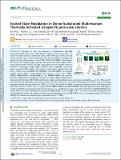Excited-state modulation in donor-substituted multiresonant thermally activated delayed fluorescence emitters
Date
09/05/2022Author
Grant ID
ep/l017008/1
EP/P010482/1
EP/P010482/1
SRF\R1\201089
RPG-2016-047
838885
Keywords
Metadata
Show full item recordAbstract
Strategies to tune the emission of multiresonant thermally activated delayed fluorescence (MR-TADF) emitters remain rare. Here, we explore the effect of donor substitution about a MR-TADF core on the emission energy and the nature of the excited state. We decorate different numbers and types of electron-donors about a central MR-TADF core, DiKTa. Depending on the identity and number of donor groups, the excited state either remains short-range charge transfer (SRCT) and thus characteristic of an MR-TADF emitter or becomes a long-range charge transfer (LRCT) that is typically observed in donor–acceptor TADF emitters. The impact is that in three examples that emit from a SRCT state, Cz-DiKTa, Cz-Ph-DiKTa, and 3Cz-DiKTa, the emission remains narrow, while in four examples that emit via a LRCT state, TMCz-DiKTa, DMAC-DiKTa, 3TMCz-DiKTa, and 3DMAC-DiKTa, the emission broadens significantly. Through this strategy, the organic light-emitting diodes fabricated with the three MR-TADF emitters show maximum electroluminescence emission wavelengths, λEL, of 511, 492, and 547 nm with moderate full width at half-maxima (fwhm) of 62, 61, and 54 nm, respectively. Importantly, each of these devices show high maximum external quantum efficiencies (EQEmax) of 24.4, 23.0, and 24.4%, which are among the highest reported with ketone-based MR-TADF emitters. OLEDs with D–A type emitters, DMAC-DiKTa and TMCz-DiKTa, also show high efficiencies, with EQEmax of 23.8 and 20.2%, but accompanied by broad emission at λEL of 549 and 527 nm, respectively. Notably, the DMAC-DiKTa-based OLED shows very small efficiency roll-off, and its EQE remains 18.5% at 1000 cd m–2. Therefore, this work demonstrates that manipulating the nature and numbers of donor groups decorating a central MR-TADF core is a promising strategy for both red-shifting the emission and improving the performance of the OLEDs.
Citation
Wu , S , Li , W , Yoshida , K , Hall , D , Madayanad Suresh , S , Sayner , T , Gong , J , Beljonne , D , Olivier , Y , Samuel , I D W & Zysman-Colman , E 2022 , ' Excited-state modulation in donor-substituted multiresonant thermally activated delayed fluorescence emitters ' , ACS Applied Materials & Interfaces , vol. Articles ASAP . https://doi.org/10.1021/acsami.2c02756
Publication
ACS Applied Materials & Interfaces
Status
Peer reviewed
ISSN
1944-8244Type
Journal article
Description
S.W. thanks the China Scholarship Council (201906250199). EZ-C and IDWS acknowledge support from EPSRC (EP/L017008, EP/P010482/1). We are also grateful for financial support from the University of St Andrews Restarting Research Funding Scheme (SARRF) which is funded through the Scottish Funding Council grant reference SFC/AN/08/020. EZ-C is a Royal Society Leverhulme Trust Senior Research fellow (SRF\R1\201089). We would also like to thank the Leverhulme Trust (RPG-2016-047) for financial support. This project has received funding from the European Union’s Horizon 2020 research and innovation programme under the Marie Skłodowska Curie grant agreement No 838885 (NarrowbandSSL). S.M.S. acknowledges support from the Marie Skłodowska-Curie Individual Fellowship. Computational resources have been provided by the Consortium des Équipements de Calcul Intensif (CÉCI), funded by the Fonds de la Recherche Scientifiques de Belgique (F.R.S.-FNRS) under Grant No. 2.5020.11, as well as the Tier-1 supercomputer of the Fédération Wallonie-Bruxelles, infrastructure funded by the Walloon Region under the grant agreement n1117545. Y.O. acknowledges funding by the Fonds de la Recherche Scientifique-FNRS under Grant n° F.4534.21 (MIS-IMAGINE). D.B. is a FNRS Research Director.Collections
Items in the St Andrews Research Repository are protected by copyright, with all rights reserved, unless otherwise indicated.

